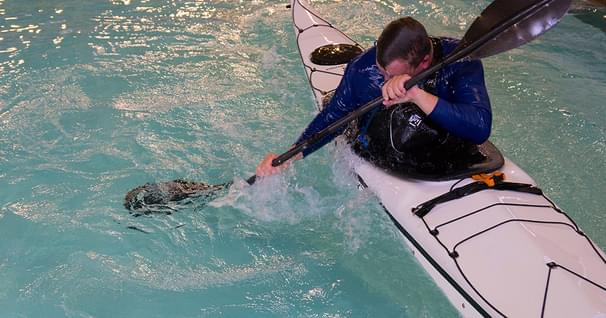SUP Pivot Turns
Pivot turns are a great way to turn your board and you can do them when you're stationary or moving. The thing about pivot turns is, you want to be comfortable moving around on your board. This basic idea of the pivot turn is to submerge the tail of your board so that your board can pivot around and the nose is elevated off the water.
At this stage, its a good idea to sit down on your board and slide to the tail to practice some pivot turns with your center of gravity a little bit lower. From the seated position, slide yourself back towards the tail of your board. Keep moving back until you find the sweet spot. The sweet spot is a spot where you'll feel balanced and can relax on the board, even though the nose is elevated out of the water. Once you found the sweet spot, try taking some forward and reverse sweep strokes, to see how much easier the board turns when you're pivoting on the tail. Also, notice that if you lean forward, the nose of the board drops, and if you lean back, the nose rises higher out of the water.
Now it's time to try some pivot turns while you're standing up. When you're doing pivot turns, the hybrid stance is a great stance to use. The reason it's so effective is because it gives you stability edge to edge, and also, nose to tail. The hybrid stance involves having your front foot, pointing forwards, slightly off the center line of the board, and your back foot pointed at about 45 degrees towards the side of the board, with the heel just across the center line. Every board has its own sweet spot for doing pivot turns and that sweet spot depends on your size in relation to the size of your board.
What you'll want to do is step back on your board, and slowly work your way back until you find a nice balanced point where the nose rises out of the water. While your moving back, your paddle should be in the water or just on the surface, ready to brace. Once you found the sweet spot, you can take forward or reverse sweep strokes to pivot your board around. When you're doing pivot turns, its important to maintain an active paddle, or at least keep your paddle right on the surface ready to engage. This paddle is acting as an active brace while we're paddling, it can also act as a brace if we need to turn or change directions, or become unstable.
As you get more and more comfortable doing pivot turns, you can try changing directions, changing hands, and stopping your board all together. You can also lean back on your back foot, and then forward on your front foot to change the angle or pitch at which your board is in the water. Once you've got your pivot turns dialed in while your stationary, try doing pivot turns while your moving forward. Once you figured out the pivot turn, a whole new world of possibilities will open up to your paddling.
Related Articles
By changing how you edge and balance your boat you can increase your stability and adaptability. Using…
Mention “pool session” and the first image that pops into most kayakers minds is a class in how to roll.…
Whether you've been canoeing for years, or you're just looking to get started, in this video we go over…
Photo Credit: Darlene Patterson Many people who have paddled for years can't keep a canoe on a straight…



